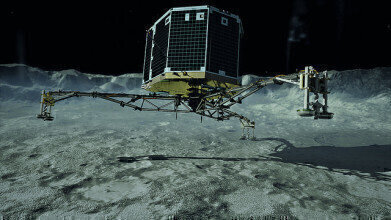News
How Did the Philae Lander Land on an 18km/s Comet?
Dec 17 2014
The £1bn Rosetta probe launched from Earth by the European Space Agency (ESA) in 2004 finally made celestial history as its lander, Philae, touched down on comet 67P on the 12th of November..
Having travelled through space for ten years and covering a distance of 6bn km, the Rosetta Mission will accomplish many galactic ‘firsts’, including the first spacecraft to land on a comet, the first lengthy study of a comet’s environment and nucleus, and the first time a comet’s activity will be studied at close proximity as it nears the Sun.
The Rosetta spacecraft arrived at a preselected position above the comet early Wednesday morning, and at 8:35 GMT the Philae lander was released, beginning its slow descent 20km to the comet’s surface.
Philae lander bounces from the comet’s surface
The preselected landing site was chosen to give the Philae the best chance of successfully landing on a flat surface, and with enough light catchment to allow recharging of its solar arrays. The landing site was one square kilometre, and it was possible for the Philae to land anywhere within this area.
At a distance of 510m km from Earth, control signals take over 28 minutes to arrive at the control centre, and over seven hours after initial separation from the Rosetta probe, they received confirmation that the Philae lander craft had finally reached the comet. However, the celebrations at the Darmstadt Control Centre were cut short. The twin harpoons which should have secured the lander to the comet had malfunctioned and not fired; the chances of the lander remaining on the comet unknown.
Shortly after, further data received from the probe indicated that the Philae was still rotating; an impossible motion if the lander was stationary. Scientists at the Lander Control Centre in Cologne concluded that the lander had bounced away from the comet. Minutes later, signal was lost.
A clear picture of the landing
The connection was re-established Thursday morning at 06:00 GMT, and the data received gave the control centres a clearer idea of what had happened when the signal had been lost.
Despite the Philae landing within 50 meters of the chosen site and signal given to the harpoons to fire, the lander’s anchors did not work. Due to the weak gravitational force of the comet, the Philae bounced 1km off the surface, returning two hours later only to bounce once again.
During this timeframe, the comet rotated, and the Philae eventually touched down at 17:33 in a position which proved problematic, as it was mostly in darkness. The electrical power ran down, and the instruments eventually shut down. However, it is possible that by August 2015, when the comet is closer to the Sun, the lander could receive enough solar energy to awaken. Our finders are crossed.
If you’d like to know more about this fascinating mission, take a look at this story: 4 Incredible Facts about the Rosetta Mission. Or, if you think that something is amiss with this mission, take a look at: Is the Rosetta Mission Another Roswell?
Digital Edition
Lab Asia Dec 2025
December 2025
Chromatography Articles- Cutting-edge sample preparation tools help laboratories to stay ahead of the curveMass Spectrometry & Spectroscopy Articles- Unlocking the complexity of metabolomics: Pushi...
View all digital editions
Events
Jan 21 2026 Tokyo, Japan
Jan 28 2026 Tokyo, Japan
Jan 29 2026 New Delhi, India
Feb 07 2026 Boston, MA, USA
Asia Pharma Expo/Asia Lab Expo
Feb 12 2026 Dhaka, Bangladesh



















